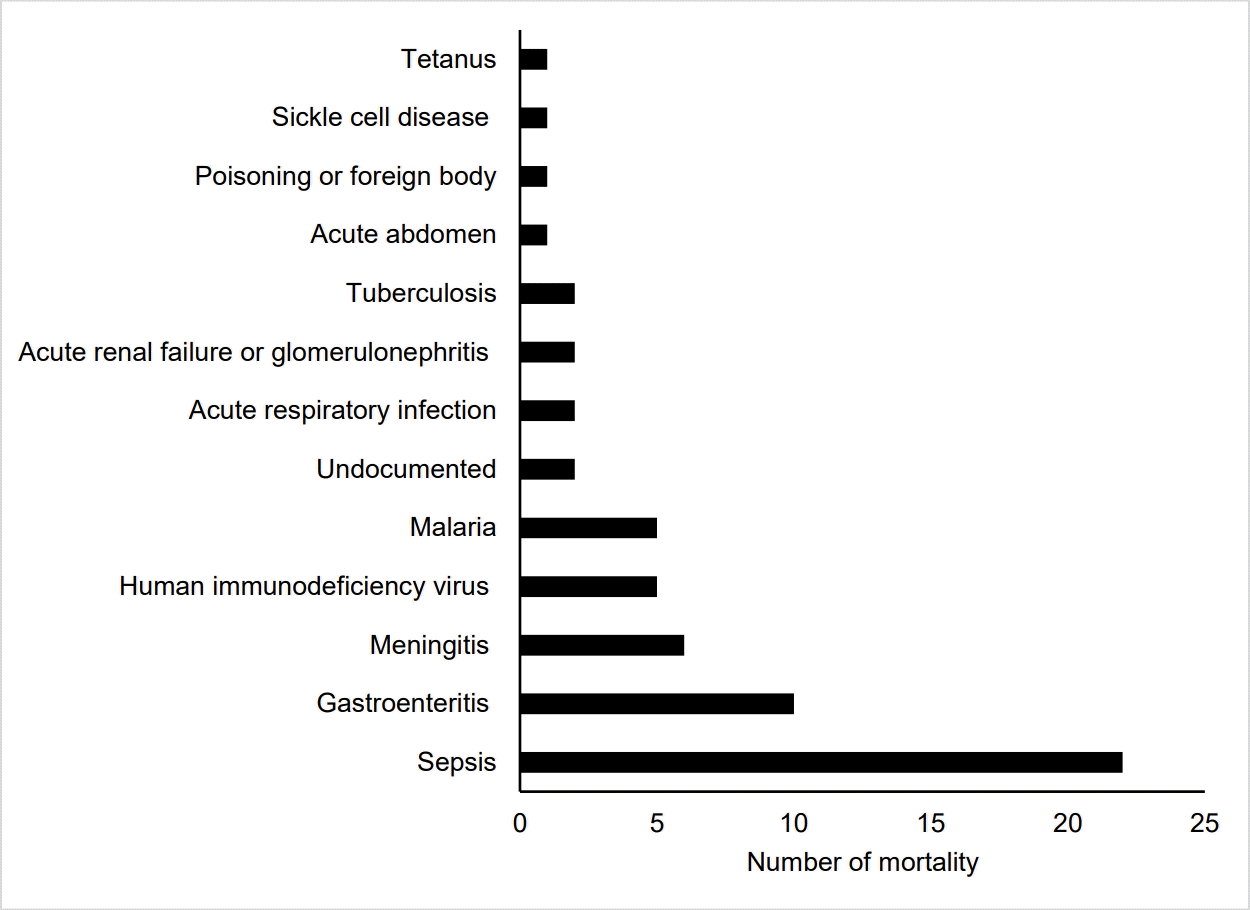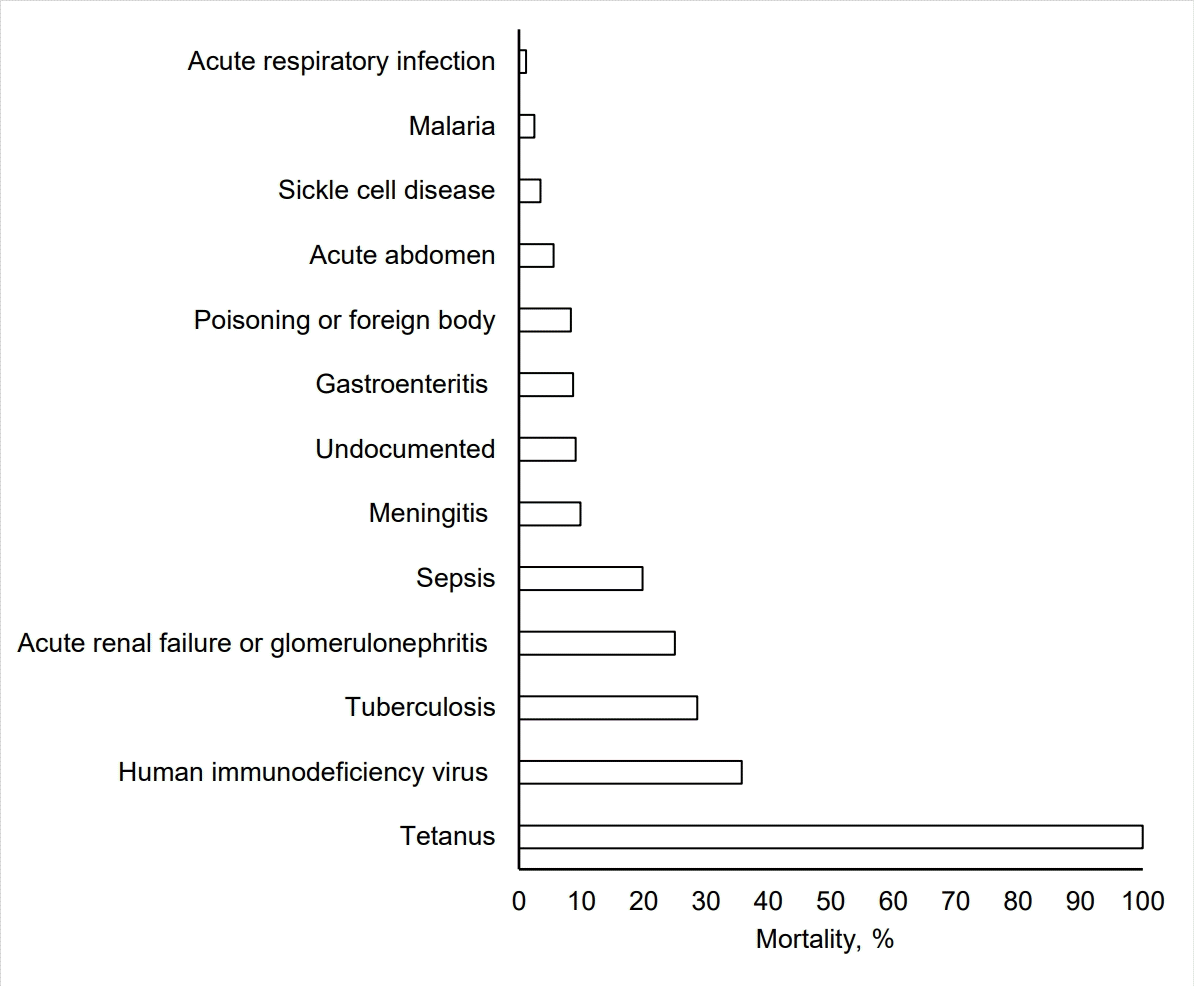2. Whitehead PR. The lived experience of physicians dealing with patient death. BMJ Support Palliat Care. 2014; 4:271–6.
3. Zhu CP, Wu XH, Liang YT, Ma WC, Ren L. The mortality of patients in a pediatric emergency department at a tertiary medical center in China: an observational study. World J Emerg Med. 2015; 6:212–6.
4. Lopez E, Udaondo J, Olabarri M, Martinez-Indart L, Benito J, Mintegi S, et al. Mortality in Spanish pediatric emergency departments: a 5-year multicenter survey. Eur J Emerg Med. 2017; 24:392–7.
5. Tette EMA, Nyarko MY, Nartey ET, Neizer ML, Egbefome A, Akosa F, et al. Under-five mortality pattern and associated risk factors: a case-control study at the Princess Marie Louise Children’s Hospital in Accra, Ghana. BMC Pediatr. 2016; 16:148.
6. Jofiro G, Jemal K, Beza L, Bacha Heye T. Prevalence and associated factors of pediatric emergency mortality at Tikur Anbessa specialized tertiary hospital: a 5 year retrospective case review study. BMC Pediatr. 2018; 18:316.
7. Edelu BO, Eze JN, Oguonu T, Ndu IK. Morbidity and mortality pattern in the children emergency unit of the University of Nigeria Teaching Hospital Enugu. Orient J Med. 2014; 26:73–8.
8. Enyuma CO, Ikpeme OE, Brown-Abang E, Uket H. Morbidity and mortality pattern in a children emergency room in Calabar, Nigeria. J Med Africa. 2016; 1:6–10.
9. Onyearugha CN, Okoronkwo NC, Onyemachi PE. Mortality pattern in children aged 1-60 months at a tertiary healthcare institution, in Southeast Nigeria. Ann Med Health Sci Res. 2020; 10:907–11.
10. Ibeziako SN, Ibekwe RC. Pattern and outcome of admissions in the children’s emergency room of the University of Nigeria Teaching Hospital, Enugu. Niger J Paed. 2002; 29:103–7.
11. Njoku PU, Iloh GU, Dienye PO, Korie FC, Ahaiwe VC. Pattern of paediatric conditions seen in the children emergency room of an urban hospital in South-Eastern Nigeria. GSC Biol Pharm Sci. 2020; 13:174–80.
12. Singhi S, Jain V, Gupta G. Pediatric emergencies at a tertiary care hospital in India. J Trop Pediatr. 2003; 49:207–11.
13. Brugnolaro V, Fovino LN, Calgaro S, Putoto G, Muhelo AR, Gregori D, et al. Pediatric emergency care in a low-income country: characteristics and outcomes of presentations to a tertiary-care emergency department in Mozambique. PLoS One. 2020; 15:e0241209.
14. Duru C, Peterside O, Akinbami F. Pattern and outcome of admissions as seen in the paediatric emergency ward of the Niger Delta University Teaching Hospital, Bayelsa State, Nigeria. Niger J Paed. 2013; 40:232–7.
15. Okoronkwo NC, ChappJumbo AU. Pattern of morbidity and mortality of childhood illnesses at the children emergency room of Abia State University Teaching Hospital, Aba, Nigeria. East Central Afr Med J. 2015; 2:70–3.
16. Sa’ad YM, Hayatu A, Al-Mustapha II, Orahachi YM, Hauwa MU. Morbidity and mortality of childhood illnesses at the emergency pediatric unit of a tertiary hospital, north-eastern Nigeria. Sahel Med J. 2015; 18:1–3.
17. Molyneux EM. Paediatric emergency care in resource-constrained health services is usually neglected: time for change. Ann Trop Paediatr. 2010; 30:165–76.
18. Ndukwu CI, Onah SK. Pattern and outcome of postneonatal pediatric emergencies in Nnamdi Azikiwe University Teaching Hospital, Nnewi, South East Nigeria. Niger J Clin Pract. 2015; 18:348–53.
19. Ibeneme CA, Ezuruike EO, Korie FC, Chukwudi NK, Ukpabi IK. Morbidity pattern and outcome among under-fives at the children’s emergency room of Federal Medical Center Umuahia. Niger J Paediatr. 2019; 46:189–94.
20. Kingwengwe AA, Ndgadi AK, Lukusa PM, Ilunga PM, Ibeki EK, Kyanga PA, et al. Epidemiology of pediatric medical emergencies at the Kindu reference General Hospital (HGRK): state of affairs and perspectives. Open Access Libr J. 2019; 6:e5715.
23. Mathers C. Deaths of older children: what do the data tell us? Lancet Glob Health. 2015; 3:e579–80.
24. Ngwalangwa F, Phiri CHA, Dube Q, Langton J, Hildenwall H, Baker T. Risk factors for mortality in severely ill children admitted to a tertiary referral hospital in Malawi. Am J Trop Med Hyg. 2019; 101:670–5.






 PDF
PDF Citation
Citation Print
Print



 XML Download
XML Download